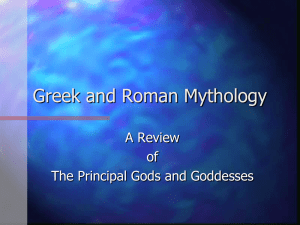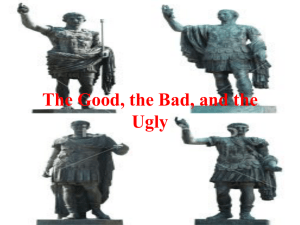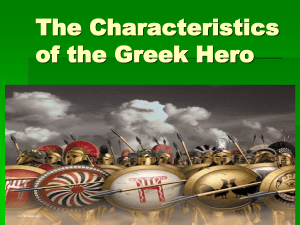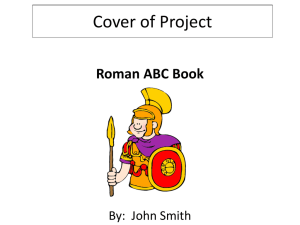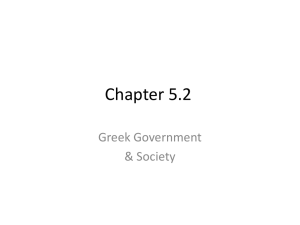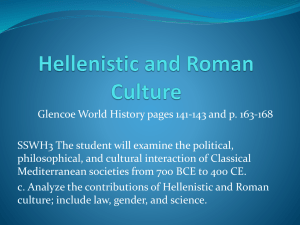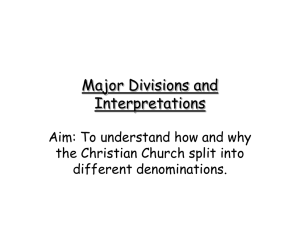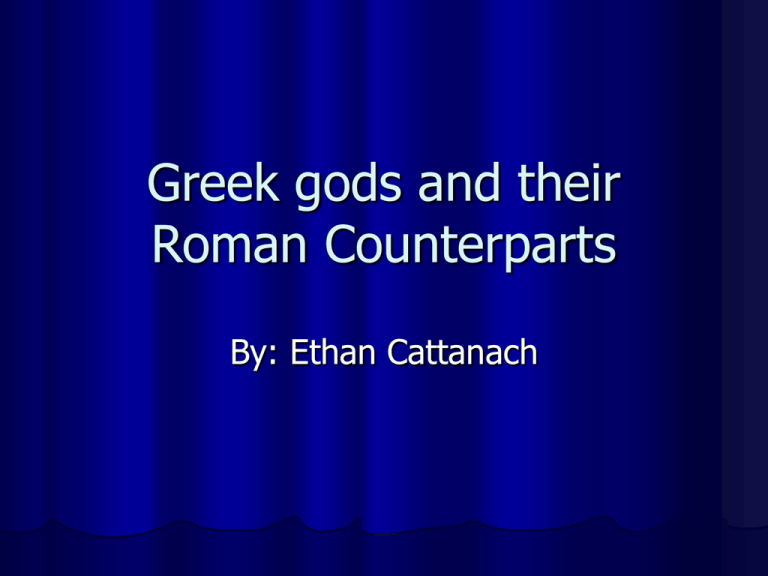
Greek gods and their
Roman Counterparts
By: Ethan Cattanach
The Twelve Olympian Gods
Zeus/Jupiter
Hera/Juno
Poseidon/Neptune
Dionysus/Bacchus
Hermes/Mercury
Hephaestus/Vulcan
Aphrodite/Venus
Ares/Mars
Artemis/Diana
Apollo
Demeter/Ceres
Athena/Minerva
Zeus/Jupiter
Zeus
Zeus was the Greek ruler of the Olympian gods
He was married to Hera
Zeus was the god of the sky, rain, thunder, lightning
His symbol was the eagle and/or the lighting bolt
Jupiter
Jupiter was the Roman King of the Gods
He was married to Juno (his sister)
He was the god of the sky, thunder, light, lightning
His symbols were storms, clouds and lightning
Hera/Juno
Hera
Hera was the Greek god of love and marriage
She was the Queen of Heaven
Her symbols were the cow and peacock
She had a lot of children (Ares, Hephaestus, Hebe,
Eileithyia,)
Juno
Juno was the Roman god of marriage, hearth, family and
childbirth
Her symbols were a peacock and a goat skin cloak
She was the Queen of the Gods
Poseidon/Neptune
Poseidon
Poseidon was the Greek god of the sea, earthquakes, and sea
storms
He was married to Amphitrite (goddess of the sea)
Poseidon's sacred animal was the horse because he made it
out of sea foam
Neptune
Neptune was the Roman god of horses and the sea
Neptune was married to Salacia (goddess of salt water and the
sea)
Neptune's sacred animal was the horse
Dionysus/Bacchus
Dionysus
Dionysus was the Greek god of grape harvest, winemaking,
wine, ritual madness, drunkenness, vegetation, pleasure,
parties and big cats
He was married to Ariadne
His parents were Zeus and Semele
Bacchus
Bacchus was the Roman god of wine and inspired madness
He hated owls, which were the symbol of his sister, Minerva
His symbols were ivy, snakes, and grapes
Leopards were his sacred animal
Hermes/Mercury
Hermes
Hermes was the Greek god of herds, travel, speed, trade,
heraldry, language, athletics and thievery
He was married to Hera
He was the son of Zeus and Maia, a daughter of the titan, Atlas
Pan was the son of Hermes
Mercury
Mercury was the Roman god of trade, profit, merchants,
thievery and travelers
He was not married
Hephaestus/Vulcan
Hephaestus
Hephaestus was the Greek god of fire, forges, volcanoes,
metal, crafts
He was sometimes called Lord of the Fire, The Smith God, and
Master Craftsman
He was married to Aphrodite
Vulcan
Vulcan was the Roman God of Fire and the blacksmith of the
gods
He was the son of Jupiter and Juno
His festival, the Vulcanalia, was celebrated on August 23 when
the summer heat put the crops and granaries at risk of burning
He was the husband of Venus
Aphrodite/Venus
Aphrodite
Aphrodite was the Greek goddess of love, desire, beauty,
fertility, and vegetation
She was married to the crippled god, Hephaestus
Her children were Deimos, Adrestia, Harmonia, The
Erotes, Eros, Anteros, Himeros, Pothos, Rhode, Tyche,
Peitho, Eunomia
Venus
Venus was the Roman goddess of love, beauty, sex,
fertility, prosperity, and military victory
She was married to Vulcan
Ares/Mars
Ares
Ares was the Greek god of war, battle lust, war booty, city
defense, civil order, anger, violence, courage, fear, and manly
courage
Ares did not marry, but he did have an affair with Aphrodite
His chariot was driven by four fire-breathing dragons: Aithon
(Red-Fire), Phlogios (Flame), Konabos (Tumult), and Phobos
(Fear)
His sacred day was Tuesday
His bird was the vulture
Mars
Mars was the Roman god of war, civil order, bloodlust, and
brigands
Ares was his Greek counterpart
Artemis/Diana
Artemis
Artemis was the Greek goddess of the hunt, wild animals,
childbirth, disease, plague, sudden death, girls, dance, song,
the waxing crescent moon
She was the protector of the vulnerable
Her animals were dogs, guinea fowl, elephant, horses, bear,
dove, deer, and the bee
Her gem was the Moonstone
Diana
Diana was the Roman goddess of the moon and hunting
She was one of the three maiden goddesses, Diana, Minerva
and Vesta, who swore never to marry
Apollo
Apollo
Apollo was the Greek/Roman god of prophecy, music, light,
intellectual pursuits, healing, plague, the sun, poetry, colonists,
medicine, archery, dance, reason, and boys
He was the patron defender of herds and flocks
Apollo was not married
His parents were Zeus (Jupiter) and Leto (Latona)
Apollo’s children were Aristeaus, Trolius, Orpheus and
Asclepius
His animals were the swan, the raven and the wolf
His weapons were a golden bow and golden arrows
His name was the same in Greek and in Roman Mythology
Demeter/Ceres
Demeter
Horn of Plenty
Demeter was the Greek goddess of agriculture (wheat and
barley), milling, bread, vegetables, pig-farming, motherhood,
and blessed afterlife
Her sacred plants were wheat, barley, mint, poppy
Her sacred bird was the Turtle-dove
Her parents were Rhea and Chronos
Ceres
Ceres was the Roman goddess of growing plants, motherly
love, agriculture, grain
Athena/Minerva
Athena
Athena was the Greek goddess of wisdom, war, crafts, weaving
Athena invented the flute, the plough, the ox-yoke, the horse
bridle, and the chariot
Athena was a virgin goddess
She was born from Zeus's head
Minerva
Minerva was the Roman goddess of wisdom and war
Her symbol was the owl
She was the daughter of Jupiter and Juno
Nature gods and goddesses
River Gods & Water Nymphs/Naiads
Rivers of the Underworld
Other Nymphs/Dryads
Pan/Faunus - Satyrs/Fauns
Selene/Luna
Zephyrus/Favonius - Eurus/Vulturnus
Notus/Auster - Boreas/Aquilo
Iris
Helios/Sol - Eos/Aurora
Persephone/Proserpina
Amphitrite/Salacia
River gods
Water Nymphs/Naiads
River gods
River Gods were always male
There was a river god in every stream, river, canal, etc.
The best known river god was Achelous
Water Nymphs/Naiads
Naiads were fresh-water Nymphs who inhabited the rivers,
streams, lakes, marshes, fountains and springs of the earth
Pegaiai were the Naiad Nymphs of springs
Krenaiai were the Naiad Nymphs of fountains
Potameides were the Naiad Nymphs of rivers & streams
Limnades and Limnatides were the Naiad Nymphs of lakes
Heleionomai were the Naiad Nymphs of marshes and wetlands
Rivers of the Underworld
Lethe
Lethe was the river of forgetfulness
Lethe flowed around the cave of Hypnos and through the
Underworld, where all those who drank from it
experienced complete forgetfulness
Styx
Styx was the river of hate
It was a river which formed the boundary between Earth
and the Underworlds. It circled the underworld nine times.
If you were to bathe in it, your skin would be like iron
except for a tiny spot
Rivers of the Underworld
Cocytus
Cocytus was the river of lamentation
Those who died and were not properly buried were stuck
walking about the banks of this river for most of their afterlife
Acheron
Acheron was the river of woe
The ferryman, Charon, ferried the dead across Acheron from
the land of the living to the realm of Hades
Phlegethon
Phlegethon was the river of fire
It is said that while the fire burned, it did not consume anything
within its flames
Other Nymphs/Dryads
Cloud Nymphs/Nephelai/Nephelae
Nephelai were nymphs of clouds and rain who rose up from the
earth bearing water to the heavens in cloudy pitchers. With their
rain, they nourished the earth and fed the streams of their rivergod brothers.
Wind Nymphs/Aurai/Aurae
Aurai were the nymphs of the breezes. They were daughters of
the north-wind Boreas.
Air Nymph
Air Nymphs spent most of their time in the skies, and could
effect the weather through their manipulation of air currents.
Other Nymphs/Dryads
Nereids
Nereids were Nymphs of the sea and the ocean.
Dryads
Dryads were wood Nymphs or forest Nymphs.
They were very shy.
They lived in trees.
Pan/Faunus
and Satyrs/Fauns
Pan pipes
Pan
Pan was the Greek god of creativity, nature, animals, panic, and
music. He was often seen playing Pan pipes
His parents were Hermes and the Nymph Dryope
Pan was half man and half goat, with goat ears, horns and legs
Faunus
Faunus was the Roman rustic god of animals and forests
His wife was Fauna
Satyrs/Fauns
Satyrs were Greek rustic spirits of the wilderness and
countryside. They were close companions of the Greek god Pan.
They mated with the Nymphai nymphs
Fauns were Roman rustic spirits of the Roman god Faunus
Selene/Luna
Selene
Selene was the Greek goddess of the moon
Her parents were Theia and Hyperion
Her siblings were Helios (God of the sun) and Eos (Goddess of
dawn)
She was one of the Greek triple moon goddesses: Artemis Waxing Moon, Selene - the Full Moon, and Hecate - the Waning
Moon
Luna
She was the Roman goddess of the moon, animals, and
hunting
Luna was one of the Roman triple moon goddesses: Luna,
Trivia, and Diana
Zephyrus/Favonius
Eurus/Vulturnus
Spring
Zephyrus
Fall
Zephyrus was the Greek god of the west wind, he was thought to
bring spring
His parents were Eos and Astraeus
His siblings were Boreas, Eurus and Notus
Favonius
Favonius was the Roman god of the west wind
He was sometimes represented as mere gusts of wind, at other
times he was personified as a winged man
Eurus/Vulturnus
Eurus was the Greek god of the east wind, and bringer of fall
His Roman counterpart was Vulturnus
Notus/Auster
Boreas/Aquilo
Summer
Winter
Notus
Notus was the Greek god of the South Wind
He was the bringer of wet summer
Auster
Rain
Auster was the Roman god of the South Wind
His brothers were Aquilo, Vulturnus, Favonius
Boreas
Boreas was the Greek of the north wind
He was the bringer of winter
Aquilo
Aquilo was the Roman god of the north wind
He had purple wings
Snow
Iris
Iris
Iris was the Greek/Roman goddess of the rainbow
Her parents were Elektra, a cloud-nymph, and Thaumas, a sea
god
She was also a messenger goddess
She was the messenger for Hera
Her sisters were harpies
She was often pictured with wings
She was married to Zephyrus
She was the same goddess in Greek and in Roman mythology
Helios/Sol
Eos/Aurora
Helios/Sol
Helios was the Greek god of the sun
Helios drove a chariot led by 4 fire-breathing horses across the sky
each day
At night, he was carried back to his starting place in a great cup
His parents were Hyperion and Theia
Sol was his Roman counterpart
Eos/Aurora
Eos was the Greek goddess of dawn
She used to open the gates for the sun (Helios)
She was the child of Hyperion and Theia
She was the sister of Helios (the sun) and of Selene (the moon)
She had been in love with Ares, but Aphrodite cursed her so she
would be in love constantly.
Aurora was Eos’s Roman counterpart
Persephone/Proserpina
Persephone
Persephone was the Greek goddess of flowers and harvest
She was the Queen of the Underworld
Her animals were the bat, ram, parrots, all talking birds, and
monkeys
Her parents were Zeus and Demeter
Proserpina
Proserpina was the Roman goddess of the harvest and of the
underworld
Her parents were Jupiter and Ceres
Cupid had instructions to hit Pluto with an arrow of love, so Pluto fell
in love with Proserpina and kidnapped her. Proserpina’s mother,
Ceres, went looking for her. Ceres created deserts with her
footprints. Then, she stopped all growth. Finally, Pluto let Proserpina
go (after she ate 6 pomegranate seeds). For eating the seeds,
Proserpina has to spend 6 months a year in the underworld, while
Ceres mourns and stops all growth (winter and fall). When
Proserpina leaves the underworld, Ceres rejoices and starts growth
again (spring and summer)
Amphitrite/Salacia
Amphitrite
Amphitrite was the Greek goddess of the sea
She was the Queen of the Sea, and was the mother of fish,
seals and dolphins
Her parents were Nereus and Doris
Her son was Triton and her daughter was Rhode
She was married to Poseidon
Salacia
Salacia was the Roman goddess of salt water
She was married to Neptune
Gods of Living and Dying
Hades/Pluto
Thanatos/Mors
Hypnos/Somnus
Morpheus
Plutus
Morae/Parcae (Fates)
Erinyes/Furies (Dirae)
Hades/Pluto
Hades
Hades was the Greek god of death
He was the king of the underworld
He was married to Persephone
He was the ruler of the dead
Pluto
Pluto was the Roman god of riches and death
Pluto was married to Proserpine
He was NOT the lord of the dead
His job was to run the underworld
Hades' Invisible
helmet
Thanatos/Mor
Thanatos
Thanatos was the Greek god of a non-violent death
His brother was Hypnos
Thanatos worked for Hades
His parents were Nyx (night) and Erebus (darkness)
His nephew was Morpheus
Mor
Mor was the Roman god of death
He worked for Pluto
Thanatos was his Greek counterpart
His dad is Nox
Hypnos/Somnus
Hypnos
Hypnos was the Greek god of sleep
His parents were Erebus (the god of darkness) and Nyx (the
god of night)
He was married to Pasithea (the goddess of hallucinations)
His children were Morpheus (god of dreams), Phobetor (god of
nightmares), Phantasus, and Ikelos.
He lived in the underworld
Somnus
Somnus was the Roman god of sleep
He was the brother of death and the son of night
It was said that he had a thousand children (all gods/goddess of
dreams).
Morpheus
Morpheus
Morpheus was the Greek and Roman god of dreams, and in
later mythology he became a god of sleep
He was the son of Hypnos and Pasithea
He was the nephew of Thanatos
Morpheus sent human images into dreams, Phobetor sent
animal images into dreams, and Phantasos sent object images
into dreams
Together, they ruled dreams
Morpheus had black wings
Morpheus only had 1 name in Greek and Roman mythology
Plutus
Plutus
Plutus was the Greek and Roman god of wealth
His mother was Demeter
Plutus was blinded by Zeus, so that he could not tell good from
evil unless his sight was restored but it was not
Plutus was sometimes confused with Pluto, god of the
underworld and wealth
Plutus had the same name in Greek and Roman mythology
Fates
(Morae/Parcae)
Fates
The Fates determined how long a person would live
There were 3 fates: Klotho, Lachesis, and Atropos
Klotho spun the thread of life
Lachesis determined the length of the thread
Atropos cut the thread when the proper time came for death
Their parents were Nyx and Erebus
Morae was the Greek name for the Fates
Parcae was the Roman name for the Fates
Erinyes/Furies
(Dirae)
Erinyes/Furies (Dirae)
The Erinyes were the goddesses of vengeance
They pursued wrong-doers relentlessly, until death, often driving
them to suicide
There were three Erinyes/Furies (Dirae): Tisiphone, Megaera,
Alecto
Tisiphone – Goddess of murder
Megaera – Goddess of envious anger
Alecto – Goddess of unending anger
The Erinyes came from the blood of Uranus when he was cut
up
Their weapon was the whip
The Furies and Dirae were the Roman names for the Erinyes
Other Gods/Goddesses
Hestia/Vesta
Eris/Discordia
Eros/Cupid (Amor)
Nemesis/Invidia
Nike/Victoria
Muses
Graces/Charities
Hestia/Vesta
Hestia
Hestia was the Greek goddess of the house, home, family
hearth, civic hearth, and sacramental flame
Her parents were Chronos and Rhea
She had no children and no husband
Vesta
Vesta was the Roman goddess of fire, bread, and the hearth
Her sacred animal was the donkey
Her festival days were Jan 15, Feb 13, March 1, April 28, May
15, June 7-15, June 24
Her gem was the black diamond
Eris/Discordia
Eris
Eris was the Greek goddess of strife, discord, contention, war,
and rivalry
Her parent was Nyx
Her children were Ponus, Lethe, Limos (and a lot of others)
Eris started the Trojan War by throwing the golden apple in front
of many goddesses
Discordia
Discordia was the Roman goddess of discord, strife, and war
She is the Roman counterpart of Eris
Eros/Cupid
(Amor)
Eros
Eros was the Greek god of love
His mother was Aphrodite
His father was Ares
He was married to Psyche
His child was Volupta (Pleasure)
He created birds
Cupid/Amor
Cupid was the Roman god of love
He was shown as a winged baby holding a bow and arrow
The arrows Cupid shot made people fall in love with the first
person they saw.
Nemesis/Invidia
Nemesis
Nemesis was the Greek goddess of revenge and justice
Nemesis was a goddess of requirement; she had to correct evil
deeds done or undeserved good fortune
Her mother was Nyx - she had no father
Invidia
Invidia was the Roman goddess of envy and jealously
Nemesis was her Greek counterpart
Nike/Victoria
Palm branch (sign of victory)
Nike
Nike was the Greek goddess of victory
She was shown with wings
Her father was Pallas (who Athena killed), and her mother was
Styx (the Naiad)
Her siblings were Kratos (strength), Bia (force), and Zelus
(rivalry)
Victoria
Victoria was the Roman
goddess of victory
Her Greek counterpart was
Nike
Coins that show
Victoria
Muses
Muses
Clio: Goddess of history and poetry
Urania: Goddess of astronomy
Melpomene: Goddess of tragedy
Thalia: Goddess of comedy
Terpsichore: Goddess of dance
Calliope: Goddess of epic or heroic poetry
Erato: Goddess of love and poetry
Polyhymnia: Goddess of songs/hymns to the gods
Euterpe: Goddess of music and lyric poetry
The Muses were daughters of Zeus and Mnemosyne
The Muses were believed to inspire artists, poets, and musicians.
Graces/Charities
Graces/Charities
The Graces were minor goddesses who symbolized beauty,
charm, and goodness
Aglaia - Goddess of brightness or splendor
Thalia – Goddess of good cheer
Euphrosyne – Goddess of joyfulness
Cleta – Goddess of sound
Pasithea – Goddess of shining
Peitho – Goddess of persuasion
The Graces are the daughters of Zeus and Eurynome
The Graces are the Greek name
The Charities are the Roman counterpart
Titans/Primeval Forces
Gaia/Terra (Primeval Force)
Tartarus (Primeval Force) –
Uranus/Ouranos (Primeval Force)
Cronus/ Saturn – Typhon
Oceanus – Atlas
Coeus & Phoebe – Hyperion & Theia –
Rhea/Cybele (Ops)
Crius & Mnemosyne – Iapetus & Themis
– Tethys
Prometheus
Gaia/Terra
Gaia
Gaia was the Greek primeval force of earth
She was born from Chaos
Her siblings were Eros, Tartarus and Nyx
Her children were Uranus, Cronus, Pontus, The Ourea,
Hecatonchires, Cyclopes, titans, The Gigantes, Nereus,
Thaumus, Phorcys, Ceto, Eurybia, Aphrodite, and Typhon
Terra was Gaia’s Roman counterpart
Tartarus – Uranus/Ouranos
Tartarus
Tartarus was the Greek/Roman primeval force of the
underworld and he was the bottomless pits of the world
He lived under the earth and held together the bottomless pits
of the world, which is where monsters go when they are killed
Uranus/Ouranos
Uranus was the Greek primeval force of the sky
He had children with Gaia. He put the some of his children in
Tartarus. Gaia wanted her titan children to kill Uranus for this
act. None of the titans wanted to do that, except for Chronos.
Gaia gave Chronos a scythe and he chopped Uranus up. Then,
Chronos ruled the titans.
Ouranos was Uranus’s Roman counterpart
Cronus/Saturn - Typhon
Cronus
Cronus was the Greek titan of time
His father was Uranus and his mother was Gaea
His children were Hestia, Hades, Demeter, Poseidon, Hera, Zeus,
and centaurs
Saturn was his Roman counterpart
Typhon
Typhon was the Greek/Roman titan/monster of the wind and storms
Gaia and Tartarus were his parents
He was the father of all monsters and his wife (Echidna) was the
mother of all monsters
Oceanus – Atlas
Oceanus
Oceanus was the Greek/Roman titan of the sea
He was the son of Gaia and Uranus
He was marred to Tethys
He was the father of nymphs, 3,000 Rivers, and Seas
He did not fight in the war against the gods
Atlas
Atlas was the titan of the Heavens
He was brother to Prometheus and Epimetheus, who did not
fight the Olympians
He fought with the titans in the war against the gods, so Zeus
punished him and then he held the sky
Coeus & Phoebe – Hyperion &
Theia – Rhea/Cybele (Ops)
Coeus & Phoebe
Coeus and Phoebe were both Greek/Roman titans of the moon
Coeus was the son of Gaia/Terra and Uranus/Ouranos
Phoebe was the parent of Leto, who was the mother of Artemis
& Apollo
Hyperion & Theia
Hyperion and Theia were both Greek/Roman titans of the sun
They were the parents of Helios (Sun), Selena (Moon), and Eos
(Dawn)
Rhea/Cybele (Ops)
Rhea was the Queen of the heavens
Rhea was the mother of 6 Olympians
Her Roman name was Cybele and/or Ops
Crius & Mnemosyne – Iapetus
& Themis – Tethys
Crius & Mnemosyne
Crius and Mnemosyne were both Greek/Roman titans of
memory
Iapetus & Themis
Iapetus and Themis were both Greek/Roman titans of justice
and planets
Iapetus was the father of Prometheus, Epimetheus, and Atlas
Tethys
Tethys was the Greek/Roman titaness of the ocean
She was the mother of all river gods and Oceanids (which were
sea nymphs or mermaids)
Prometheus
Prometheus
Prometheus was the Greek/Roman titan of forethought
He created the first man
He gave man fire
He got chained to a cliff in the Caucasus mountains
Zeus sent an eagle daily to pluck out his liver
Greek Gods/Titans Chart
Monsters and Weird Creatures
Scylla and Charybdis – Sirens –
Minotaur - Cyclopes
Cerberus – Argus – Hydra - Gorgons
Centaurs – Pegasus – Chimera
Sphinx - Hecatonchires (the hundred
handed ones) - Nemean Lion - Harpies
Echidna - Stymphalian Birds - Kraken
Graeae sisters - Geryon
Hellhound
Monsters and Weird Creatures
1
Scylla and Charybdis
Scylla and Charybdis were a pair of monsters who lived at the Strait
of Messina. Scylla used to be a water nymph, but Amphitrite turned
her into a monster with 6 heads and 3 rows of sharp teeth.
Charybdis was a whirlpool. Together, they ate people.
Sirens
Sirens had the head of a female human and the body of a bird. They
lived on an island where they lured people to their death by singing.
Minotaur
The Minotaur was half bull and half man. Theseus killed it.
Cyclopes
Cyclopes were 1 eyed giants. They were the children of Uranus and
Gaia.
Cyclopes is the plural term for Cyclops.
Monsters and Weird Creatures
2
Cerberus
Cerberus was a 3 headed dog that protected the gates of the
underworld. Mother: Echidna, Father: Typhon
Hercules kidnapped Cerberus
Argus
Argus was a monster with 100 eyes. He was the protector of Hera.
Hydra
Hydra was a monster with 9 heads. If one head got cut off, 2 new
heads would grow back. It only could be killed with fire. Hercules
killed the Lernean Hydra.
Gorgons
There are 3 Gorgon monsters: Euryale, Sthenno, and Medusa.
Medusa is the only one of them who was mortal. If you looked into a
Gorgon’s eyes, you would be turned to stone. They had snakes for
hair. Perseus killed Medusa.
Monsters and Weird Creatures
3
Centaurs
Centaurs were part human and part horse. Centaurs are the
followers of the wine god, Dionysus. Chiron, who trained a lot of
the heroes, was a centaur.
Pegasus
Pegasus were horses with wings. The first Pegasus came from
Medusa’s head
Chimera
Chimera had the head of a lion, the body of a she-goat, and the
tail of a dragon. Chimera was a child of Typhon and Echidna.
Monsters and Weird Creatures
4
Sphinx
The Sphinx had the body of a lion, head of a human, and wings
Hecatonchires
The Hecatonchires were children of Gaia and Uranus. They had
100 arms and 50 heads each. Their names were Cottus,
Briareus, and Gyges. Uranus locked them up in Tartarus
Nemean Lion
The Nemean Lion was a huge lion with iron skin. No weapons
could hurt it. Hercules finally strangled it
Harpies
The Harpies were winged monsters with the face of an ugly old
woman and crooked, sharp talons
Monsters and Weird Creatures
5
Echidna
Echidna was half woman, half snake. She was known as
Mother of All Monsters because most of the monsters in Greek
mythology were her children.
Stymphalian Birds
Stymphalian birds were a flock of man-eating birds which
haunted Lake Stymphalus in Arkadia. Heracles destroyed them
as his sixth labor, using first a rattle to rouse them from the thick
vegetation of the lake, then shooting them down one by one
with bow and arrow or a sling
Kraken
The Kraken was similar to a giant octopus or squid, though
earliest stories describe it as a giant crab. It preyed on ships
and then ate them.
Monsters and Weird Creatures
6
The Graeae Sisters
The Graeae Sisters were sea-spirits. They were grey from birth,
and shared among themselves a single eye and tooth. Perseus
stole the eye and tooth, and made the Graeae Sisters reveal
the hidden location of their sisters, the Gorgons. There were
three Graeae Sisters.
Deino – Which means the terrible
Enyo – Which means the warlike
Persis – Which means the destroyer
Geryon
Geryon was a 3-bodied, 4-winged giant who dwelt on the red
island of Erytheia
He possessed a fabulous herd of cattle whose coats were
tinged red by the light of sunset. Heracles was sent to fetch the
cattle as one of his twelve labors.
Monsters and Weird Creatures
7
Hellhounds
Hellhounds were dogs from hell
Cerberus, the three headed hound that guarded the gates of
Hades.
Orthus: the two headed dog of Geryon.
Laelaps: the dog that always caught his prey
Chryseus: the “Golden Dog”, who was sent to guard Zeus as an
infant
Heroes/Warriors
Achilles – Theseus
Heracles/Hercules
Odysseus
Perseus – Jason
Bellerophon
Amazons
Achilles – Theseus
Achilles
Achilles was the son of the sea nymph, Thetis, and King Peleus. He
was trained by Chiron. He was almost immortal, since his mother
had dipped him into the river Styx as a baby. This made Achilles’
whole body (except for a small part on his ankle) like iron.
Theseus
Theseus was the prince who killed the Minotaur
Every 7 years, 14 children (7 boys & 7 girls) were picked to go to
Crete to be killed in the labyrinth by the Minotaur as sacrifices. The
third time, Prince Theseus took the place of a man, so that he could
kill the Minotaur. Theseus’ father (the king) gave him a white flag, so
that when Theseus came back, the king would know that he was
alive. When Theseus got to Crete, the princess of Crete gave him a
sword and a ball of thread, to help him get out of the labyrinth. When
he got to the middle of the labyrinth, he killed the minotaur. Then he
left Crete with the princess. But when he was sailing back, he forgot
to put the white flag up on the mast, and so the king committed
suicide in grief.
Heracles/Hercules
Heracles/Hercules
Heracles got 12 labors to complete, so he could clear his name from
wrong doings:
1. Kill the Nemean Lion
2. Kill the Lernean Hydra
3. Capture the Cerynian Hind
4. Capture the Erymanthian Boar
5. Clean the Augean Stables
6. Kill the Stymphalian Birds
7. Capture the Cretan Bull
8. Capture the Horses of Diomedes
9. Take the Belt of the Amazon Queen
10.Capture the Cattle of Geryon
11. Take the Golden Apples of the Hesperides
12. Capture Cerberus
After his labors, he married. His wife gave him a cloak with what she
thought was love potion, but it was really covered in burn poison (by
Hera). Heracles would have burned himself alive (the pain), but then
Zeus gave him immortality.
Heracles is the Greek name
Hercules is the Roman counterpart
Odysseus
Odysseus
Odysseus was the King of Ithaca
He helped the Greeks triumph in the Trojan War
Afterward, he journeyed nearly ten years to return home to
Ithaca and to his wife, Penelope.
He saved himself and his men from such monsters as the
Cyclops, the Sirens, and Scylla and Charybdis.
When he got back to Ithaca, Odysseus proved his identity to
Penelope and once again ruled his homeland.
Perseus – Jason
Perseus
Perseus was the son of Zeus and Danaë
He slew the Gorgon, Medusa, with a shiny shield from Athena
and winged sandals from Apollo
Perseus killed Medusa by looking in the reflection of the shield
After he killed Medusa, he saved the princess, Andromeda,
from being eaten by a sea monster (he turned it to stone).
Jason
Jason was the leader of the Argonauts (the 50 heroes). Jason's
uncle, Pelias, had stolen the kingdom that belonged to Jason
Pelias promised to return the kingdom only if Jason would bring
home the Golden Fleece
On their journey, Jason and the Argonauts faced down many
monsters
Bellerophon
Bellerophon
Bellerophon was the son of Poseidon
King Iobates of Lycia sent Bellerophon on a suicide quest to
destroy the fire-breathing monster known as the chimera. With
the help of his winged horse, Pegasus, Bellerophon was able to
complete the task safely. He then conquered the Solymi and the
Amazons.
Upon Bellerophon's return to Lycia, King Iobates gave him half
his kingdom and his daughter
After a while, the gods did not like Bellerophon because he tried
to get up to Olympus on Pegasus.
Amazons
Amazons
Amazons were a large group of women that were warlike.
These women were said to be brave, with strength and fortitude
like no other women
An Amazon woman was raised from childhood to fight, therefore
they truly knew what they were doing and could protect their
people at all costs
Not many people stood a chance against the Amazons
They did not like men
If the Amazons had boy children, they would either kill them or
give them to a neighboring men’s tribe
They worshiped Ares (because they were warlike) and Artemis
(because she was a maiden goddess).
Websites that I used a lot!
http://gogreece.about.com
http://www.theoi.com
http://www.pantheon.org
http://www.dl.ket.org
http://www.greek-gods-and-goddesses.com
http://mythagora.com
http://ancienthistory.about.com

